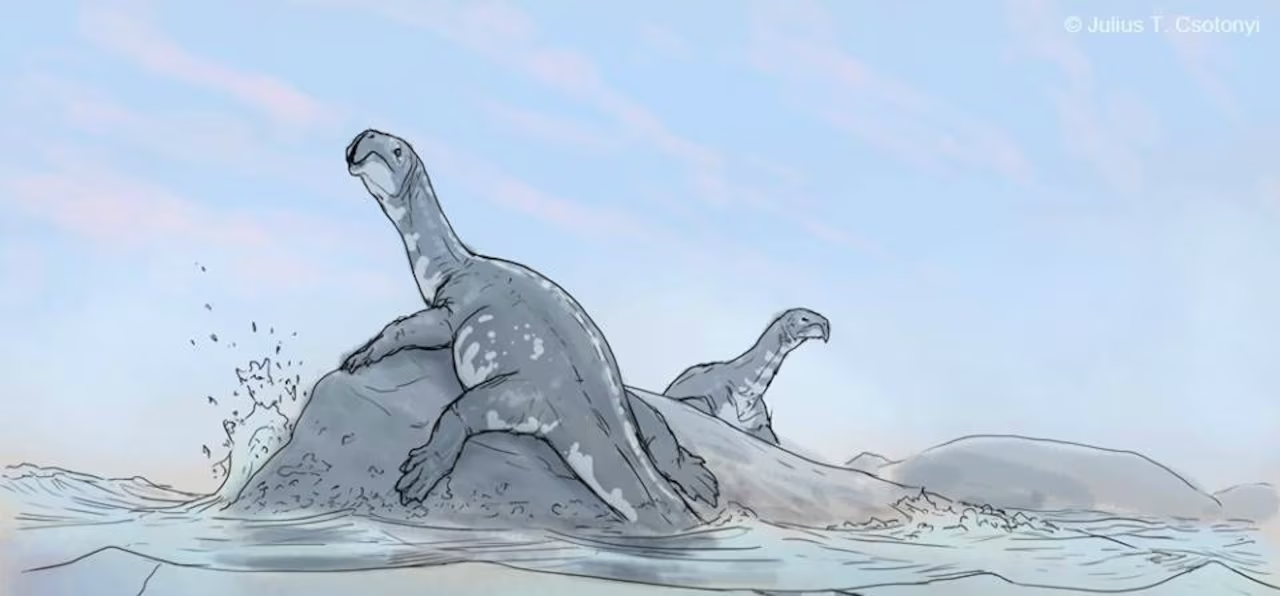
Atopodentatus in Yunnan
Atopodentatus is an extinct genus of marine reptile, possibly basal sauropterygian, known from the early Middle Triassic(Pelsonian substage, Anisian stage) of Luoping County, Yunnan Province, southwestern China. It contains a single species, Atopodentatus unicus. It is thought to have lived between 247 and 240 million years ago, during the Middle Triassic period, about six million years after the Permian extinction. Atopodentatus was an herbivorous marine reptile, although marine reptiles are usually omnivores or carnivores.
A near complete skeleton along with a left lateral portion of the skull were discovered near Daaozi village, Yunnan, China. The scientific name derives from the peculiar zipper-shaped morphology of the holotype specimen’s jaws and unique dentition.[2]However, two fossil skulls discovered in 2016 indicate that the holotype skull was badly damaged, and that the living animal actually had a hammer-shaped head with shovel-like jaws.
Description
Atopodentatus is 3 metres (9.8 ft) long. The geological strata in which the fossil was found, the elongated body, reduced neck, robust appendages and hips of Atopodentatus all suggest that the reptile was probably semi-aquatic in nature.
Originally, the upper mandible of Atopodentatus was believed to have small teeth running along the jawline, and then up along a vertical split in the middle of the upper jaw. This gave the upper jaw the appearance of a “zipper smile of little teeth”. The upper jaw was believed to have hooked downwards. Discoveries in 2016, however, overthrew these findings, and revealed that Atopodentatus actually had a hammer-shaped head, with a bank of chisel-shaped teeth, that was useful in rooting the seabed for food.
Discovery and naming
The genus name Atopodentatus is derived from the Ancient Greek atopos (άτοπος), meaning “unplaceable, strange, extravagant, absurd, eccentric, disturbing”,[note 1] combined with Latin dentatus, “toothed”, referring to the unusual form of arrangement and shape of the teeth. The specific name “unicus” reinforces the uniqueness of the reptile’s morphology.
Paleoecology
Due to its bizarre dentition, Atopodentatus was formerly considered to be a filter feeder which fed on invertebrates along the sea-bottom. It was suggested that the morphology made Atopodentatus “capable of walking on land or tidal flats and sandy islands in the intertidal zone”. However, the 2016 findings reveal that Atopodentatus actually ate algae from the seabed, making it the second known Mesozoic herbivorous marine reptile after the sphenodontian Ankylosphenodon.Atopodentatus is the earliest known herbivorous marine reptile by about 8 million years.
Discovery and Naming
- Discovery: Atopodentatus fossils were first discovered in Yunnan Province, China, specifically in the Middle Triassic marine deposits.
- Naming: The genus name “Atopodentatus” means “strange teeth,” referring to its unusual and distinctive dental structure.
Physical Characteristics
- Appearance: Atopodentatus had a long, slender body with a unique skull adaptation.
- Skull: Its most notable feature was its downturned rostrum (snout) lined with two rows of chisel-like teeth, which initially puzzled paleontologists about its feeding habits.
Feeding Adaptation
- Feeding Mechanism: Atopodentatus is believed to have been a filter-feeder, using its specialized rostrum to scrape algae or other small organisms from surfaces such as rocks or plants in marine environments.
- Unique Discovery: The discovery of Atopodentatus provided insights into unique feeding adaptations among marine reptiles during the Triassic period.
Significance
- Paleontological Insight: Atopodentatus represents an example of convergent evolution, where unrelated species develop similar adaptations due to similar environmental pressures.
- Ecosystem Role: Understanding Atopodentatus helps in reconstructing marine ecosystems and food webs during the Middle Triassic in Asia.
Fossil Sites in Yunnan
- Yunnan Province has yielded important fossil sites that contribute to our understanding of marine reptiles like Atopodentatus during the Triassic period.
- These fossils are crucial for studying the evolution and diversity of marine life in ancient seas.
Atopodentatus remains a fascinating example of evolutionary adaptation in marine reptiles, showcasing the diversity of life during the Triassic period and its ecological interactions in ancient seas.

 7 Days GolfingTour
7 Days GolfingTour
 8 Days Group Tour
8 Days Group Tour
 8 Days Yunnan Tour
8 Days Yunnan Tour
 7 Days Shangri La Hiking
7 Days Shangri La Hiking
 11 Days Yunnan Tour
11 Days Yunnan Tour
 6 Days Yuanyang Terraces
6 Days Yuanyang Terraces
 11 Days Yunnan Tour
11 Days Yunnan Tour
 8 Days South Yunnan
8 Days South Yunnan
 7 Days Tea Tour
7 Days Tea Tour
 8 Days Muslim Tour
8 Days Muslim Tour
 12 Days Self-Driving
12 Days Self-Driving
 4 Days Haba Climbing
4 Days Haba Climbing
 Tiger Leaping Gorge
Tiger Leaping Gorge
 Stone Forest
Stone Forest
 Yunnan-Tibet
Yunnan-Tibet
 Hani Rice Terraces
Hani Rice Terraces
 Kunming
Kunming
 Lijiang
Lijiang
 Shangri-la
Shangri-la
 Dali
Dali
 XishuangBanna
XishuangBanna
 Honghe
Honghe
 Kunming
Kunming
 Lijiang
Lijiang
 Shangri-la
Shangri-la
 Yuanyang Rice Terraces
Yuanyang Rice Terraces
 Nujiang
Nujiang
 XishuangBanna
XishuangBanna
 Spring City Golf
Spring City Golf
 Snow Mountain Golf
Snow Mountain Golf
 Stone Mountain Golf
Stone Mountain Golf














